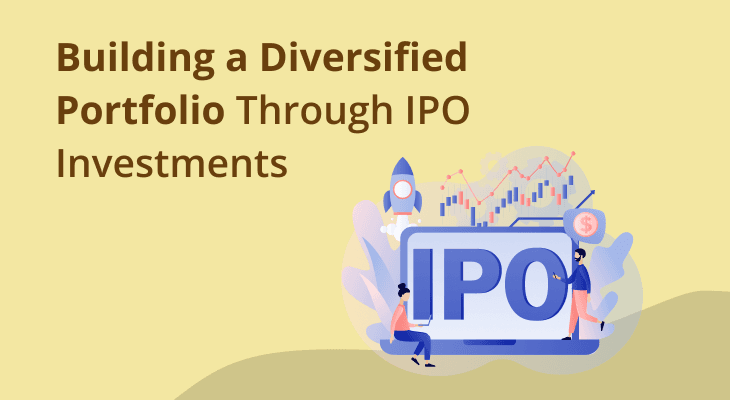
How to Build a Diversified Portfolio with IPO Investments
In recent years, India has witnessed an IPO boom with both seasoned investors and beginners looking to profit from the excitement of a company going public. But investing in IPOs requires more than just luck or trend-following; it requires strategy. More importantly, understanding how IPO investments can contribute to a diversified portfolio is key to managing risk and ensuring long-term growth.
Building a smart investment portfolio isn't about chasing high returns in isolation. It’s about combining assets that behave differently to weather market ups and downs. In this context, portfolio diversification becomes essential, and IPOs can play a valuable role if approached wisely.
This guide will help you understand IPO investments, their strategic placement in a portfolio, and how to manage associated risks while aiming for long-term success.
Understanding IPO Investments and Their Role in a Portfolio
What is an IPO?
Let’s begin with the basics. An Initial Public Offering (IPO) is when a privately held company offers its shares to the public for the first time on a stock exchange. This process helps companies raise capital to fund growth, reduce debt, or expand operations.
For investors, IPOs represent a chance to invest early in companies that could become future market leaders. However, IPOs can also be volatile and unpredictable, especially in their initial days of listing.
Are IPOs Suitable for All Investors?
Not always. While IPOs can generate quick returns, they are not guaranteed investments. The lack of long-term data, limited disclosures before listing, and high volatility mean that IPOs carry unique risks. That’s why understanding how they fit into your broader diversified portfolio is crucial.
How Do IPO Investments Contribute to a Portfolio?
- Growth Potential: IPOs can offer exposure to fast-growing businesses in sectors like fintech, biotech, or e-commerce.
- Innovation Exposure: IPOs often bring disruptive or new-age businesses to public markets.
- Sector Diversification: Adding IPOs from underrepresented sectors can expand your portfolio’s coverage.
Still, IPOs should not dominate your portfolio. Instead, they should act as satellite investments within a core-satellite strategy.
Importance of Diversification in Portfolio Building
What is Portfolio Diversification?
Portfolio diversification is the practice of spreading your investments across different asset classes, industries, and risk levels to reduce your overall exposure to market fluctuations. The idea is that when one asset class or sector underperforms, others may balance it out.
Why Is Diversification Important?
- Reduces Risk: Spreading investments limits the impact of one poor-performing asset.
- Smoothens Returns: Diversification can reduce portfolio volatility, leading to more stable returns.
- Protects Capital: Especially in volatile markets, diversification acts as a cushion.
Key Elements of a Diversified Portfolio
- Asset Classes: Equities, debt funds, gold, real estate, etc.
- Geographies: Domestic vs international exposure.
- Market Caps: Large-cap, mid-cap, and small-cap stocks.
- Themes and Sectors: Financials, healthcare, IT, energy, etc.
IPO investments typically fall under equity allocation but need to be treated carefully due to their unique characteristics.
Strategies to Diversify Using IPOs
IPO investments can seem thrilling due to their potential for sharp short-term gains. However, for long-term portfolio diversification, the approach must be much more deliberate. While IPOs are inherently equity investments, you can still use them strategically to enhance diversification. Here’s how:
1. Diversify Across IPO Sectors
Do not invest only in trending IPOs from the same sector. For instance, if you’ve already invested in fintech IPOs, avoid investing more in the same industry. Instead, look for diversity such as healthcare, manufacturing, consumer tech, or green energy. This ensures you’re not overly exposed to sector-specific risks.
2. Stagger IPO Entry Over Time
Don’t invest in all IPOs at once. Spread your IPO allocations across quarters or financial years. This staggered approach reduces market timing risk and helps you invest across different economic cycles. For example, you might invest in a defensive-sector IPO during a volatile phase and in a cyclical-sector IPO during market upturns.
3. Balance Between Established and Emerging Companies
Not all IPOs are brand-new startups. Some are established businesses looking to raise capital. For example, LIC was a government-owned enterprise with a large-scale presence, unlike smaller tech startups. Including both types, mature and emerging companies, adds a balanced risk-reward profile to your IPO basket.
4. Limit Exposure Per IPO
To avoid concentration risk, cap your investment in any single IPO. Even if a company shows promise, don't invest more than 1–2% of your total portfolio in one IPO. This protects your capital if the IPO underperforms or lists below issue price.
5. Combine IPOs with Other Equity Types
IPOs should not form the core of your equity portfolio. Combine them with blue-chip stocks, index funds, sectoral ETFs, or active mutual funds. While IPOs are single-stock, high-risk bets, ETFs offer diversified exposure across the market or sectors, balancing your risk.
6. Avoid Following Herd Mentality
IPO hype can be misleading. Avoid FOMO (fear of missing out) and investing just because everyone else is. Research the fundamentals or consult an expert, and apply only when the company has strong financials, sustainable business models, and clear valuation metrics.
7. Use IPOs to Add Thematic Exposure
Sometimes IPOs offer access to emerging themes like EVs, AI, or digital payments. You can use them to tap into megatrends if such themes are underrepresented in your current holdings. However, limit their weightage until performance stabilises post-listing.
Risk Management and Long-Term Planning
IPOs can be tempting, but carry a unique set of risks that range from valuation inaccuracies to lack of historical performance data. To use IPOs effectively in your diversified portfolio, it's essential to pair them with sound risk management strategies and a long-term view. Here are some best practices:
1. Understand the Risk Profile of IPOs
Unlike established stocks, IPO companies often lack consistent track records. Financial data might only be available for a couple of years, and future profitability is uncertain. Market sentiment plays a large role in pricing, making short-term outcomes volatile. Hence, don’t assume every IPO will list at a premium.
2. Align IPO Investments with Financial Goals
Before investing in any IPO, ask: “Does this help me achieve a long-term financial goal?” If your goal is five or ten years away, like funding a child’s education or buying a house, IPOs can be used selectively to boost potential returns. But don’t rely solely on them. Blend IPOs with safer instruments like mutual funds, PPFs, or debt funds.
3. Monitor Post-Listing Performance
Risk doesn’t end after IPO allotment. Regularly track the stock’s performance, quarterly results, and management commentary. Set a maximum loss threshold, say 15–20% below listing price, and be ready to exit if the fundamentals change. Don’t hold just out of emotional attachment.
4. Avoid Overtrading and Speculation
Many investors sell immediately after listing to book quick profits, while others hold blindly expecting multi-bagger returns. Both approaches can backfire. IPO investing should follow the same discipline as stock investing that is based on research, goals, and asset allocation, not speculation. If the fundamentals remain solid, consider holding IPO stocks long-term to benefit from compounding and business growth.
5. Rebalance Portfolio Periodically
Review your overall portfolio allocation every 6–12 months. If IPO investments have grown disproportionately or underperformed, rebalance accordingly. This prevents IPO exposure from skewing your risk profile.
6. Maintain Adequate Liquidity
IPO applications often require funds to be blocked during the allotment process (ASBA). Always maintain adequate liquidity in your bank account and avoid using emergency or essential funds. Also, since IPOs can lock in capital post-listing if the stock performs poorly, ensure you're not compromising liquidity needs.
7. Use Mutual Funds That Invest in IPOs
If you're not confident in analysing IPOs yourself, consider mutual funds or PMS (portfolio management services) that invest in IPOs. These are managed by professionals who assess fundamentals and entry timing, making it a safer way to gain IPO exposure indirectly.
Conclusion
IPO investments can bring energy and growth to your diversified portfolio, but only when approached with discipline, research, and a balanced mindset. They are not substitutes for long-term equity funds or core holdings but can complement your strategy when used wisely.
Remember, portfolio diversification is not just about spreading investments—it's about making thoughtful, goal-aligned decisions that manage risk and maximise returns. IPOs are one of many tools available to help you build a smart, resilient portfolio.
As an investor, your goal should be to blend innovation (IPOs), stability (mutual funds), and safety (debt or gold) into a unified investment approach. That’s how you future-proof your wealth and invest with confidence.
FAQ
What is an IPO in investing?
An IPO, or Initial Public Offering, is when a private company offers its shares to the public for the first time. Investors can buy shares during this phase to become part-owners, often hoping to benefit from early-stage growth.
Can IPO investments help diversify a portfolio?
Yes, IPO investments can diversify your portfolio by adding exposure to new sectors or innovative companies. However, they should complement—not replace—existing investments like mutual funds, ETFs, and bonds to maintain overall balance.
How much of my portfolio should be in IPOs?
A safe allocation would be around 5–10% of your equity exposure. IPOs are high-risk, high-reward investments, so limiting your allocation ensures you manage volatility while exploring growth opportunities.
Are IPOs riskier than mutual funds?
Generally, yes. IPOs involve newly listed companies with limited public history, making them more volatile. Mutual funds offer built-in diversification, while IPOs are concentrated bets on single companies.
What’s the best way to evaluate an IPO?
Study the company's financials, business model, sector outlook, use of funds, and valuations. Read the prospectus and compare it with listed peers. Avoid applying based solely on hype or grey market premiums.
Should I invest in every IPO that comes out?
No. Not every IPO is worth investing in. Be selective based on research and portfolio fit. Avoid overexposure by applying only to companies with strong fundamentals and long-term potential.
Can IPO investments be used for long-term goals?
Yes, but only selectively. If the IPO company has a solid business model and growth prospects, it may support long-term goals. However, high-risk IPOs should be balanced with stable instruments.
How do IPOs fit into a diversified portfolio?
IPOs act as satellite investments. They can enhance growth but should sit alongside core holdings like mutual funds, ETFs, or index funds to maintain diversification and reduce concentration risk.
Is it okay to sell IPO shares right after listing?
That depends on your goal. Some investors book profits post-listing if prices surge. Others hold for long-term gains. Assess fundamentals, valuation, and your financial plan before deciding.
What are alternatives to IPOs for portfolio diversification?
You can diversify using mutual funds, ETFs, debt funds, gold, or international stocks. These offer lower volatility and broader exposure, making them essential companions to high-risk IPO holdings.
